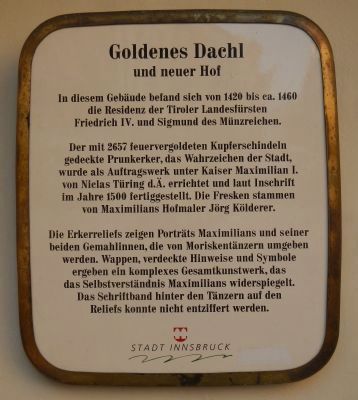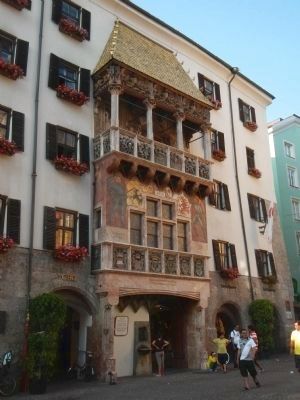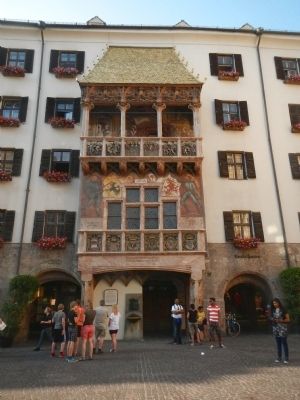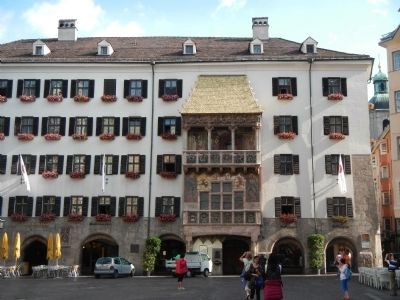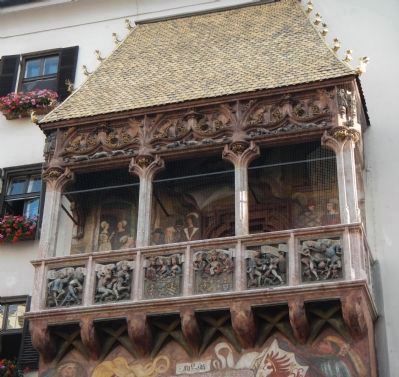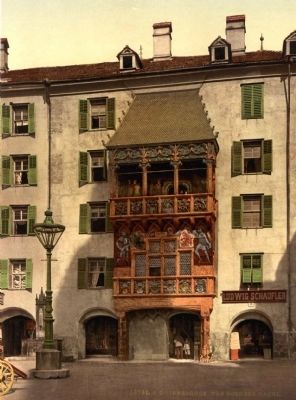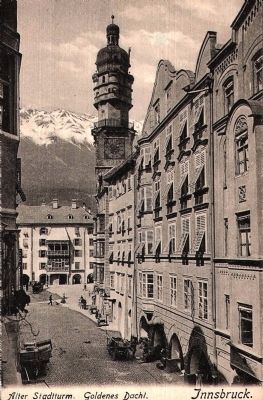Innenstadt in Innsbruck, Tyrol, Austria — Central Europe (Eastern Alps)
The Golden Roof and New Courtyard
Goldenes Dachl und neuer Hof
In diesem Gebäude befand sich von 1420 bis ca. 1460 die Residenz der Tiroler Landesfürsten Friedrich IV. und Sigmund des Münzreichen.
Der mit 2657 feuervergoldeten Kupferschindeln gedeckte Prunkerker, das Wahrzeichen der Stadt, wurde als Auftragswerk unter Kaiser Maximilian I. von Niclas Türing d.Ä. errichtet und laut Inschrift im Jahre 1500 fertiggestellt. Die Fresken stammen von Maximilians Hofmaler Jörg Kölderer.
Die Erkerreliefs zeigen Porträts Maximilians und seiner beiden Gemahlinnen, die von Moriskentänzern umgeben werden. Wappen, verdeckte Hinweise und Symbole ergeben ein komplexes Gesamtkunstwerk, das das Selbstverständnis Mazimilians widerspiegelt. Das Schriftband hinter den Tänzern auf den Reliefs konnte nicht entziffert werden.
German-English translation:
From 1420 to 1460 this building was the residence of the Tirolean sovereigns, Frederick IV and Sigmund the Wealthy.
The roof of the magnificent oriel, covered with 2,657 fire-gilded copper tiles, serves as a symbol of the city. Nicholas Türing the Elder was commissioned by Emperor Maximilian I to construct and complete the building in 1500, according to the inscription. The frescoes are by the Emperor Maximilian's court painter, Jörg Kölderer.
The bay reliefs show portraits of Maximilian and his two consorts, who are surrounded by Moorish dancers. The crest, along with hidden clues and symbols together result in a complex work of art that reflects Maximilian's self-understanding. The band with writing, behind the dancers on the reliefs, could not be deciphered.
Erected by Stadt Innsbruck (City of Innsbruck).
Topics. This historical marker is listed in this topic list: Notable Buildings. A significant historical year for this entry is 1420.
Location. 47° 16.115′ N, 11° 23.594′ E. Marker is in Innenstadt, Tirol (Tyrol), in Innsbruck. Marker is at the intersection of Herzog-Friedrich-Straße and Herzog-Friedrich-Straße, on the right when traveling west on Herzog-Friedrich-Straße. Touch for map. Marker is at or near this postal address: Herzog-Friedrich-Straße 15, Innenstadt, Tirol 6020, Austria. Touch for directions.
Other nearby markers. At least 8 other markers are within walking distance of this marker. Der "Neue Hof" mit den Goldenen Dachl (here, next to this marker); Hölblinghaus (here, next to this marker); Jakob Hutter (here, next to this marker); Bederlunger House (a few steps from this marker); a different marker also named Hölblinghaus (a few steps from this marker); The Old City Hall / City Tower (within shouting distance of this marker); Historisches Rathaus (within shouting distance of this marker); Prechthaus (within shouting distance of this marker). Touch for a list and map of all markers in Innenstadt.
Also see . . . Golden Roof - Wikipedia. Wikipedia entry:
The Golden Roof was built by Archduke Friedrich IV in the early 15th century as the residence of the Tirolean sovereigns. The Golden Roof actually is the three-story balcony on the central plaza at the heart of the Old Town. (Submitted on August 26, 2013, by Barry Swackhamer of Brentwood, California.)
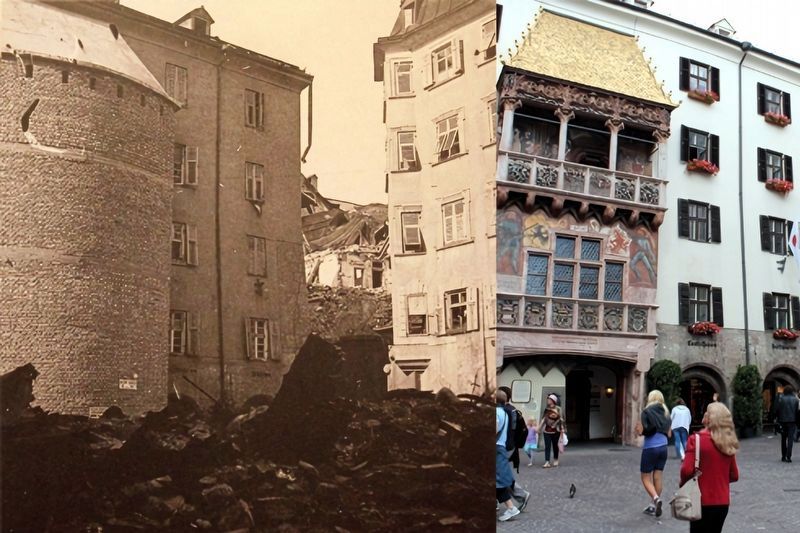
via Let's Go Exploring, unknown
8. Protecting the building during World War II
During World War II Innsbruck suffered from both occupation by Axis powers and aerial bombing from the Allies. In the mid and late war years the city was slammed on multiple occasions from Allied bombs which devastated the nearby railroad yards and many surrounding buildings. The Altstadt area also received bomb damage. To protect this treasure, the people of Innsbruck encased the Goldenes Dachl in a thick bunker to protect it from damage. At the war’s end the bunker was removed; amidst the surrounding ruins of war the preserved Goldenes Dachl shown brightly and became a symbol of hope during Innsbruck’s rebuilding.
Credits. This page was last revised on November 24, 2023. It was originally submitted on August 26, 2013, by Barry Swackhamer of Brentwood, California. This page has been viewed 614 times since then and 12 times this year. Photos: 1, 2, 3, 4, 5. submitted on August 26, 2013, by Barry Swackhamer of Brentwood, California. 6, 7. submitted on September 23, 2013. 8. submitted on November 24, 2023, by Larry Gertner of New York, New York. • Andrew Ruppenstein was the editor who published this page.
